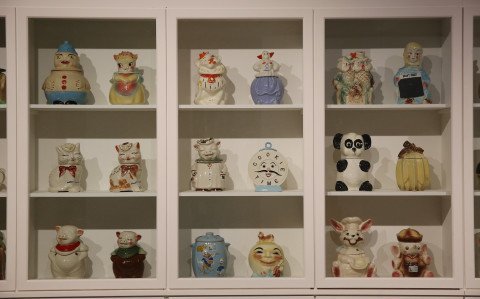Artist as collector: on show at the Barbican the difference between cultural and object values
- Andy Wharhols cookie jars collection. Magnificent Obsessions: The-Artist as Collector, Barbican Art Gallery. ©Peter MacDiarmid, Getty Images.
- Damien Hirst collection. Magnificent Obsessions. The-Artist as Collector, Barbican Art Gallery.©Peter MacDiarmid Getty images.
- Edmund de Waals, Hare with Amber Eyes netsuke. Magnificent Obsessions: The-Artist as Collector, Barbican Art Gallery. ©Peter MacDiarmid, Getty Images.
- Jim Shaws, thrift store paintings collection. Magnificent Obsessions: The Artist as Collector, Barbican Art Gallery. ©Peter MacDiarmid, Getty Images.
- Martin Wong collection, Dahn Vo artwork. Magnificent-Obsessions: The Artist as Collector Barbican Art Gallery. ©Peter MacDiarmid, Getty Images.
It always seems better when collections, especially in the context of public museums, are displayed in a way enhancing their property to create critiques, rather than just their idolisation as heaps of expensive objects. In this regard we have recently proposed some questions about the exhibition of artwork collections as hoards, raising the issue of identifying the difference between cultural and object values. Nevertheless it is clear that amassments can indeed become culture, though in order to do so they appear to need artistic interventions or narrations; the current exhibition at London’s Barbican Centre proves it quite radically.
Entitled “Magnificent Obsessions: The Artist As Collector“, the show consists of the personal collections of 14 artists, all of them active in the last 60 years, along with works from their specific artistic practice. As the press releases states, The Artist As Collector aims to “provide insight into the inspirations, influences, motives and obsessions of artists” through the show of “mass-produced memorabilia, popular collectibles, one-of-a-kind curiosities, rare artefacts, specimens” and whatever else these fourteen individuals might have accumulated over the years.
When put into dialogue with the subjectivity of their collectors, these objects cease to have intrinsic value and become cultural and critical signs despite their amassment and even the impossibility to be seen within their multitude. In the case of the cookie jars and tin toys from Andy Warhol’s hoard, or the music scores collected by Sol Le Witt on display in the show, little matters if one specific specimen remains hid by others, as long as their specificity as accumulation can create a flourishing discourse about where these artists were looking for the inspiration. Especially for Warhol, this critical speculation can get as far as a psychological analysis where the act of accumulating is seen as an obsessive response to the artist’s deprived childhood as son of immigrants in the recession-stricken US.
Our critique of displaying hoards in “public art depots” might also have to do with their lack of a critical and artistic visual set-up in space. In this regard, The Artist As Collector manages to comment on this issue and the role of vitrines in the room dedicated to Edmund de Waal. His collection of netsukes (Japanese small sculptures used to decorate kimonos) are shown in vitrines that have no apparent scope but that of properly preserving the objects in them. However, looking at de Waal’s ceramics standing on the other side of the exhibition room, one realises that these pieces also function in response to the case in which they are placed. Therefore, the audience can conclude that what is normally regarded as a simple preservation dispositif to display a heap of rare artefacts can, if inserted within a specific context, become the symbol of artistic inspiration.
Not only does The Artist As Collector manage to show collections in a critical and artistic way, it also touches a few points concerning the concept of authorship. We specifically refer to the room in which the hoard owned and assembled by Martin Wong is showed after it was appropriated by Dahn Vo and, after being bought by a museum, came to be considered a work of his. To add an extra layer of complication, the hoard already included (though we could say it hid) some artworks by Wong, making the attribution of the overall piece even more difficult.
On a different critical side, the section dedicated to Jim Shaw prompts questions about the difference between artists inside and outside the art world system: a wall is covered with his collection of thrift-store paintings while another bears a few of his original ones. Many points can be made about the references of the former in the latter while asking ourselves what made Shaw deserve the title of artist those anonymous painters didn’t get. Regardless of the possible answer – which is not the topic of this article – the point is once again the importance of a critical use of hoards in an exhibition to bring about these topics of discussions.
Overall, Magnificent Obsessions: The Artist As Collector is a finely curated and deeply thought show that, from the intimacy of the artist’s private world, manages to reach a plethora of universally important issues concerning what it means to make art. All this while managing to remind the audience that a hoard of objects would simply be a pointless heap of matter if it wasn’t for its reasoned human interpretation.
April 3, 2015





